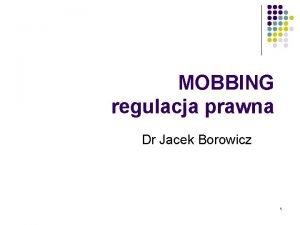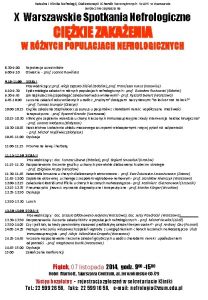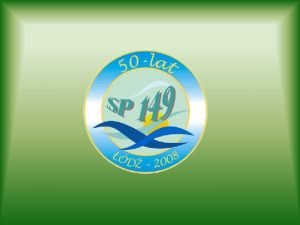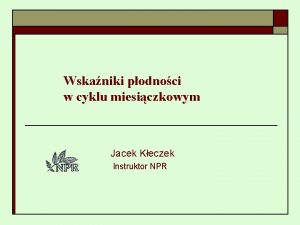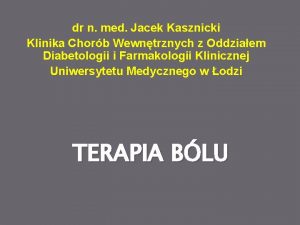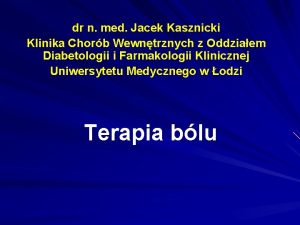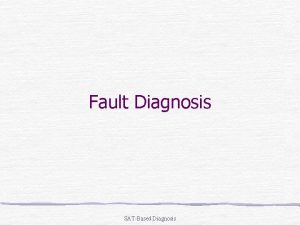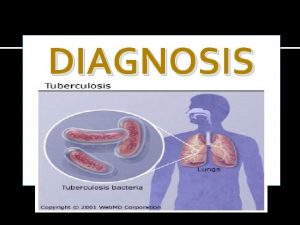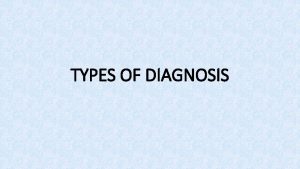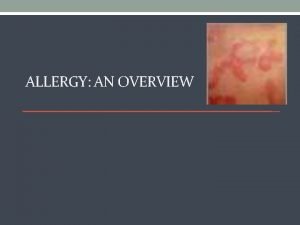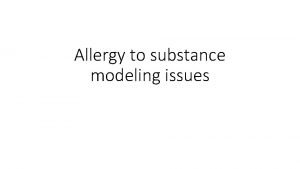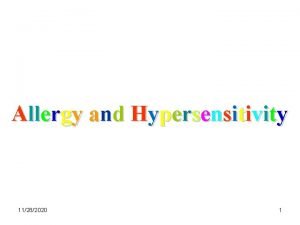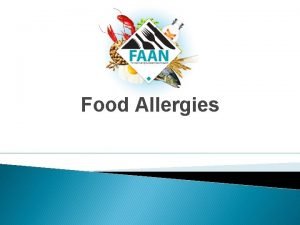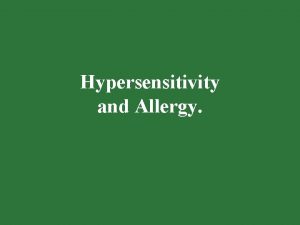Diagnosis in allergy diseasess Jacek Gocki Allergy diseasess























- Slides: 23

Diagnosis in allergy diseasess Jacek Gocki

Allergy diseasess �Asthma �Allergic Rhinitis �Eyes Allergic diaseasess �Urticaria and oedema Quincke �Athoipic dermatitis �Contact dermatitis �Food allergy �Drug alllergy �Venom allergy �Anaphylaxis and Anaphylaxic shock

Syptoms �Sujective symptoms �Breathlessness �Wheezing �Cough �Runny nose �Itching �Objective symptoms �Rash �Urticaria �Oedema �Eczema

Breathlessness � Subjective feeling no air in chest, usually connected with difficulty of taking the air to lung (in this case it is objective symptom) � Appear in: � Pneumonia � Heart failure and lung oedena � Heart ichemic diseasess and ischemic stroke � Lung emoblisation � Arrhythmia � Asthma � COPD

Breathlessness in allergy diseasess � Appear in Asthma, in anaphylactic reactions and in anphylactic shock � Breathlessness in asthma: � Paroxysmal – usually in early morning, wake up patient � Usually connected with cough after contact with allergen, infection or sudden exercise and strong emotions (scare) � Long phase of exhale, short inhale � Patient breathing by closed mouth � Could be persistent in advanced asthma � Usually abated after brochodilatator (betamimetic)

Wheezing �Abnormal high or low pithed sound. �Result of narrowing of the airways, such as result of brochospasm or increased secretion of sputum) �Two kinds: �Inhaled – congestion of upper respiratory tract outside chest (tracheitis, laryngitis, tumor or foreign body �Exhaled– congestion of low respiratory tract inside chest (Asthma, COPD, lung embolisation, heart failure, [lung oedema– early phase!!!])

Cough � Most common symptom of respiratory diseasess � Defense reflex to clean of respiratory trakt (sputum, dust, foreign body) � Mechanism: Glottis being kept closed until a high expiratory pressure has built up, and suddenly relased � Separated 10 couching a day is physiologic. . � Cogh could be involuntary and voluntary � Cough : � Acute – to 3 weeks (infestion, alergy, lung embolisation, lung oedem, foreign body, irritand dust and gases) � Subacute : 3 -8 weeks – viral infection � Persistent: 8 and more weeks (astrma, COPD, lung embolisation, cancer, tuberculosis)

Cough � Charakter: � Dry (non-productive) � � ACEI Viral infection Asthma Heart failure � Mist (produktive) � � � Sinusitis, bronchial inflamation Pneumonia COPD Asthma (sometimed) Mukowiscydozis Cancer (sometimes with blood)

Runny nose - Rhinitis � Abnormal secretion of nasal mucosa � Character: � Like a water – alergic � mucus – alergic � Purulent – infektion � Often connected with nasal congestion and sneezing (sometimes several times) � Sometimes with nasal bleeding, cough, hoarseness � Allergy Rhinitis: � Like a water or mucus � Connected with sneezing itching nose and nasal congestion � Sometimes with hoarsensess, cogh

Types of Immunological reaction �Immediate �Cytotoxic �Immunological complexes �Celular

Allergic reaction –Ig. E mediated

Urticaria �Wheal �Rednes �Itching

Oedema Quincke

Eczema �Papules �Rednes �Pustule �Itching

Skin tests �Basic tests in diagnosis of allergology �Two kinds : �PRICK �Intracutaneus �Based on Ig. E madiated reaction �Confirm presence of Ig. E specyfic antybody against allergen and Ig. E madiated reaction in skin after contact with specific allergen �Specyfic Ig. E connected with mastocyt react with allergen, and then mastocyt relase histamine caused vasodilatation

Skin PRICK test �Made by using standarised solutions of allergens �On the skin of forearm put a drop of : �Positive control (histamine solution) �Negative control (solution) �Alergen solution �Then we prick a skin by the drop using lancet �After 20 minutes read test �Positive reaction – minimum 3 mm wheal �Wheal in positive control must be minimum 3 mm �Sometimes accompanied rednes and itching

Skin PRICK test �Recomendation � Suspect allergy �Forbids � Antyhistaminic drugs – false negative results � Dermografism – false positive results � Pregnant – zagrożenie dla płodu w przypadku wystąpienia powikłań �Complications/side effects � Anaphylaxis (0, 02 -0, 04%) �Before testing: � Stop taking Antyhistaminics 3 -10 days, Imipramin and fenotiazyn � Stop taking glikokortykosteroids on skin on tested skin

Skin PRICK test � Standard kit of common allergens in Poland: � Dermatophagoides pteronyssinus � Drematophagoides farinae � Cat � Dog � Hazel � Alder � Birch � Grases and cereals � Ragweed � Cladosporium herbarum � Alternaria tenuis � Positive skin pric test not related with clinical symptoms is only positive test

Patch test � Basic tests in contact allergy � Based on celular reaction between allergen and B limphocytes � Tested allergens are puting (oitment) on 1 cm² paper, next all are puting on skin of the back and leave by oclusion for 48 h. � After 48 h remove and read results � Next reading after 24 h (72 h) and sometimes after next 24 h (96 h)

Patch tests � Recomendation � Suspected contact allergy � Forbids � Exposition for a sun – fase negative results � Using glikokortykosteroids – false negative results – stop taking min for 2 weeks before testing � Dermatitis - false positive results � Compications/side effects � Angry back syndrom � Allergy development � Acceleration of dermatitis

Patch tests � Basic kit of allergens in Europe Hapten (alergen) Cr Ni Co Tiuram Parafenylodwuamin PPD Formaldehyd Calafony Balsam of Peru Lanolin Merkaptany Żywica epoksydowa Parabens Mix perfume Quaterinum Neomycin

Patch tests � Interpretacja nickel � „ 0” or „-” – negative � IR –irritant reaction (rednes) � ‚+” – slighty positive (intumescence) � „++” – positive (+ Papules) � „+++” strong positive (+ Pustule) Positive ++

Ig. E �Tested in bood �Ig. E total �Ig. E specyfic �t. Ig. E is normal < 100 k. U/l �s. Ig. E is normal < 0, 36 k. U/l �ELISA �CAP system
 Perbedaan diagnosis gizi dan diagnosis medis
Perbedaan diagnosis gizi dan diagnosis medis Medical diagnosis and nursing diagnosis difference
Medical diagnosis and nursing diagnosis difference Medical diagnosis and nursing diagnosis difference
Medical diagnosis and nursing diagnosis difference Objectives of nursing process
Objectives of nursing process Independent nursing interventions
Independent nursing interventions Dr jacek borowicz zakaz wykonywania zawodu
Dr jacek borowicz zakaz wykonywania zawodu Dominik wojtczak lekarz szczecin
Dominik wojtczak lekarz szczecin Motyw spekulacyjny
Motyw spekulacyjny Robert jaruga
Robert jaruga Jacek kopecky
Jacek kopecky Jacek kwaśniak
Jacek kwaśniak Przemiana skawińskiego
Przemiana skawińskiego Jacek wallusch
Jacek wallusch Jacek juwa mielec
Jacek juwa mielec Cba departament analiz
Cba departament analiz Jacek becla
Jacek becla Wykres lh w cyklu
Wykres lh w cyklu Jacek kasznicki
Jacek kasznicki Jacek wiewiorowski
Jacek wiewiorowski Dr jacek borowicz zakaz wykonywania zawodu
Dr jacek borowicz zakaz wykonywania zawodu Jacek niemiec
Jacek niemiec Jacek otwinowski
Jacek otwinowski Jacek i placek wieś
Jacek i placek wieś Jacek kasznicki
Jacek kasznicki





